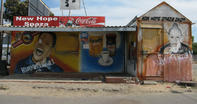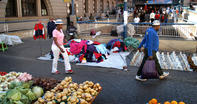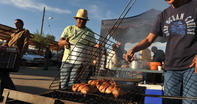Informal Retailers as a Main Source of Food
There are plenty of little shops in the small town of Witsand in the Western Cape, dotted about within the neighbourhood – a barber here, a spaza shop there, a tavern with the proprietor’s name over it, painted in by hand in primary colours.

Informal trading is as much a part of life in the slums and townships of southern Africa’s cities as the people strolling the streets here. This informal economy ticks over vibrantly, in spite of not registering on the Receiver of Revenue’s books. It is an important survival strategy, both as a means of generating local business opportunities for people, bringing income and job opportunities into the community, as well as being a source of food for so many living here.
Supermarkets are not the primary source of food for most of the people far from the usual business hubs of the city. Rather, they will spend their money at small spaza shops, restaurants, informal markets and vendors selling street foods. There is a swings-and-roundabouts component to this. Supermarket chains have bulk buying power, which pushes down the price of goods, making food more affordable to consumers.
But until recently, many of these chains have not spread their reach into townships and shanty towns (although this appears to be changing in some areas).
Spaza shops and small retailers in the townships are usually independent operators, and their prices are often higher, which is a potential barrier to good nutrition for the very consumers whose household budgets struggle most to absorb high food prices. People are probably choosing the local, informal, more expensive food sellers because it is pretty much all they have.
Informal Traders Competing with Larger Retailers
Carolyn Steel, author of Hungry City, notes that when large supermarket chains move one of their franchises into a community, the smaller mom-and-pop shops and the smaller processors and retailers often close down because they cannot compete with the prices or the range of produce.
While this is not necessarily the dynamic in a township – it is more a case of these large chains not seeing poorer neighbourhoods as a good market opportunity – the way supermarkets dot themselves through parts of the city has significant implications for poor people and how they access food.
Steel argues that small-scale local markets are key to a city being able to feed itself. Dr Bruce Frayne and others wrote for the Development Bank of South Africa (DBSA) in 2009 on the implications of the separation of small informal traders and larger retailers in South Africa’s main cities.
They noted how the drying up of the small, local food sector in the face of the supermarket giants results in ‘the decline in healthy food and the marginalisation of the poor in relation to food. Expensive transport and limited access to both distribution markets and to retail outlets (such as supermarkets) results in the urban poor having to rely on often expensive and nutritionally inadequate sources of local food.
For poorer urban entrepreneurs, the opportunities to get food at wholesale prices from centralised markets, and to compete with the large retailers, are restricted, reducing their business reach and income potential.’ One coping mechanism for communities that are reliant on more expensive local markets is to buy on credit from stores, and settle up come month-end when they get cash again.
Independent shopkeepers are usually more amenable to offering credit for food; supermarket chains less so. So the independent operators become an important survival option for the poor, even though their prices are higher.
Informal Traders in Poor Communities

University of Cape Town geographer Dr Gina Ziervogel and Dr Bruce Frayne of the University of Waterloo in Canada comment on the dualistic nature of the food sector in many developing country contexts, where formal and informal food economies run congruent with one another. Informal traders tend to be generalist traders and stick to a core range of basic commodities.
The food economy at this level becomes something of a closed loop, where producers are often consumers of the same commodities. Writing about the important functions of the informal food economy, Ziervogel and Frayne point out that capital investment in informal shops is usually very low, and that innovation is ‘more social than technical’.
‘Social networks provide low cost or free labour in the form of apprentice help or family members who are fed but receive little or no pay,’ they say, while ‘many informal food economy operators keep no accounts and avoid paying taxes. Although the informal economy overwhelmingly addresses the needs of households and micro-enterprises with limited purchasing power, it would be a mistake to imagine that the formal and informal food sectors are distinct and separate.
There is growing competition between the two sectors in poor areas of cities and the informal economy also sources an increasing amount of produce from the formal sector.’ The possible disruption within communities as a result of climate change has the potential to undermine this important livelihood strategy.
Since many people in these communities run businesses such as tuck shops and spazas out of their homes, ‘when climate-related disasters damage or destroy houses, the infrastructure required to earn a livelihood is removed’. It is not surprising to see many street vendors in Witsand, selling fresh fruit and vegetables, cooked take-aways or factory-produced chips and sweets from pavement stalls.
Urbanisation and Street Food
City life tends to push us more and more towards the convenience of street vendors. It is often cheaper, both in terms of time and money, to buy pre-prepared food on the hoof rather than pick up the raw ingredients and cook something up ourselves at home. But besides the obvious problem of buying energy-dense and nutrient-light processed foods, which typify the kinds of foods stocked by informal stallholders, there is the issue of how sanitary that food is.
Rapid urbanisation has made street foods more and more a part of our day, because they offer us cheap and quick meal options, writes the United Nation’s Food and Agriculture Organization (FAO), and typically include cooked meals, but also fizzy cooldrinks, fruit juice, dairy drinks and the ubiquitous snack foods.
‘The meals and snacks served on the streets cater for a wide variety of customer tastes and range from traditional recipes of rice or maize with vegetables and beans, to more modern items including various types of fried or grilled meats, potatoes and bread.
Quality and Safety of Street Food

Many countries do not regulate street vendors and it is therefore possible to enter into street food vending with a relatively low start-up cost, making this activity attractive to many low-income urban residents,’ says the FAO in its 2004 study on how globalisation has impacted on food and nutritional security in developing countries.
The two chief concerns about the kinds of foods you will buy on the kerbside are those of quality and safety. But, according to the FAO, there is not much research on how safe street foods are, compared with the more rigorously controlled and monitored formal sector where licensed restaurants have to adhere to municipally monitored health and safety standards.
One study, for instance, conducted by the World Health Organization’s Africa office, found unacceptably high levels of bacterial contamination in the samples it took from street food vendors in Ghana. ‘In this study, the microbial quality of most of the 511 food samples was within acceptable limits.
Of the 26 types of foods (each food was sampled from multiple vendors) included in the study, four items – salad and macaroni dishes, red pepper and fufu – had total bacterial counts above acceptable limits.’ The FAO maintains that a ‘lack of knowledge about sanitary practices, vehicle pollution, absence of structural insect barriers and scarcity of water for preparation and cleaning up all contribute to the likelihood of street foods being unhygienic’.
Certainly for communities where HIV infection rates are high, and immune systems dangerously compromised as a result, sanitary food is a critical aspect of the food security debate and one that has not received enough attention until now.
By Leonie Joubert